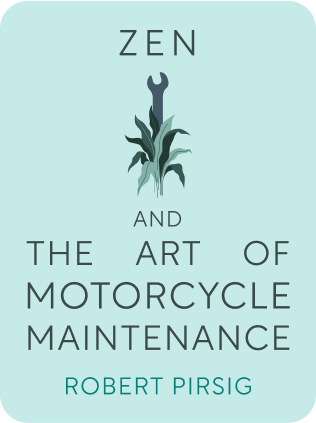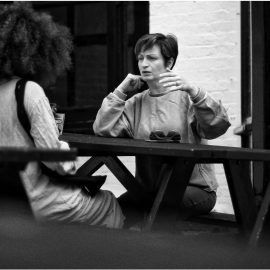

This article is an excerpt from the Shortform book guide to "Zen And The Art Of Motorcycle Maintenance" by Robert Pirsig. Shortform has the world's best summaries and analyses of books you should be reading.
Like this article? Sign up for a free trial here .
What is the chautauqua meaning? What are chautauquas and why does Robert Pirsig incorporate them into his book?
The chautauqua meaning in Zen and the Art of Motorcycle Maintenance is a group of philosophical ideas that are woven into the narrative. They are lessons about life and its meaning and fall into a few major categories.
Read more about the chautauqua meaning in Zen and the Art of Motorcycle Maintenance.
The Second Track: Chautauqua & Meaning
The chautauqua meaning in Zen and the Art of Motorcycle Maintenance is used specifically for imparting life lessons.
Modern Technology and the Human Response
In addition to the chautauqua meaning, the chautauquas are split into a few different categories. Pirsig’s discourses on technology are a response to the “Beat” and “Hippie” cultural movements, which equated “technology”—machinery, engineering, physical science—with either soulless consumption or catastrophic innovations like the hydrogen bomb. Drawing on Phaedrus’s thought, Pirsig divides humanity into two kinds of thinkers:
- Classical thinkers, who assess objects in the world in terms of their functions; and
- Romantic thinkers, who assess objects in the world in terms of their appearance.
John Sutherland is Pirsig’s prime example of a romantic thinker. Sutherland refuses to learn how to maintain his motorcycle because it’s “square”—it smacks of cold, procedural knowledge that runs counter to the “grooviness” and spontaneous creativity he prizes. Pirsig, meanwhile, a self-anointed classical thinker, relishes knowing how his motorcycle functions and being able to repair it if something goes wrong.
Pirsig’s Chautauquas on technology aim to show that technological work is creative (or, at least, can be). It’s all a matter of the mindset we bring to it. If we approach technology as though it’s something alien to us, something we can handle only with detailed instructions, then it will appear lifeless and intimidating. But if we approach it as the product of human intuition—which it was, of course, when it was invented or first constructed—we are better able to use our own intuition to engage with it. That is, when working with technology, Pirsig urges us to experiment, to try something that hasn’t been vetted by the experts, to innovate.
When we approach technology in this fashion, we’re no longer prisoner to the classical/romantic binary. We’re wedding the two by being attuned to a rarely remarked facet of our day-to-day experience. We’re attending to Quality.
Quality
The central theme of the second half of ZAMM, “Quality” was Phaedrus’s intellectual obsession and constitutes the origin of Pirsig’s musings on the classical/romantic divide.
Quality is…hard to define, especially given the fact that Phaedrus makes clear that to define Quality is to misunderstand it. Nevertheless, Phaedrus does give us some leads:
- Quality includes its colloquial sense. Although Quality has a highly technical philosophical significance (more just below), it also means “value” or “goodness.” (The subtitle of ZAMM is “An Inquiry Into Values.”) Phaedrus begins thinking about Quality in the first place because his students, without prompting, can tell the difference between a quality essay and one that lacks quality.
- Quality also includes everything else. Phaedrus’s concept of Quality placed it at the very beginning of human knowledge and experience—in fact, Phaedrus believed that Quality was the source of that knowledge and experience. Imagine the most primitive human picking up a sharp stone and using it to dig a hole. This human has no language to describe the stone or its possible uses, hasn’t been taught that sharp stones are good for digging—this human might not even fully comprehend the stone as a separate being. Nevertheless, something about the stone has drawn the human to it and caused him to pick it up and use it—that something is Quality.
- Quality is transcendent. The closest analogue Phaedrus provides for Quality is the Tao (“Path” or “Way”) as described in Lao Tzu’s Tao Te Ching, a foundational text in Chinese philosophy and religion. The Tao is a mystical entity impossible to name or adequately express, yet it generates and directs the universe. One can “know” the Tao not through words but through outlook and experience.
Pirsig devotes dozens of pages to narrating Phaedrus’s explorations of Quality. Because Quality touches all aspects of human experience, from the metaphysical to the mundane, Pirsig is able use Quality as a springboard to discuss almost anything. Over the course of 200+ pages, Pirsig covers Montana state politics, the academic discipline of rhetoric, Eastern philosophy, 19th-century mathematics, and ancient Greek philosophy, among other topics.
But it’s when Pirsig turns to the practical task of repairing a motorcycle that the power of Quality-thinking becomes clear. Essentially, to be attuned to Quality, we must cultivate a “beginner’s mindset”—we must forget what we know (or think we know) and simply meditate on the task in front of us. This is why it’s Pirsig’s firm belief that to be “stuck”—on a work or creative project, on making a life decision—is actually, counter-intuitively, the best place to be. It’s at that moment, when our go-to intellectual or emotional strategies fail us, that we begin to hook into Quality, the metaphysical something that will always lead us to a solution. Understanding the chautauquas about quality can help you understand the chautauqua meaning.
Gumptionology 101
In the final 100 pages of the book, Pirsig spends about 25 talking about gumption—which, in the ZAMM context, we can think of as “enthusiasm for the task at hand.”
Say you notice a loose doorknob. You’ve fixed doorknobs in the past, and you know exactly how to fix this one—in fact, you’re already imagining the satisfaction of getting down to work on that doorknob and repairing it without breaking a sweat. At this moment, you’re filled with gumption.
But then let’s say you can’t find the right tool—the tool you imagined wielding so skillfully—and you realize you won’t be able to fix the doorknob. Suddenly all that gumption goes up in smoke. You’ve hit a gumption trap.
Pirsig believes gumption to be both effect and promoter of Quality-thinking. If you’ve gotten stuck on a project or task, and overcome that stuckness by dint of your “beginner’s mindset,” you’re going to be brimming with gumption the next time you get stuck. And that gumption will lead you again to find novel solutions and innovative ideas (i.e., Quality).
Although Pirsig’s long list of gumption traps and workarounds is largely motorcycle-specific, there is one group of traps—“hang-ups,” or internal gumption traps—that can hamper any effort. Among these hang-ups are traits like ego (which prevents us from acknowledging stuckness and opening ourselves to Quality) and impatience (which causes us to rush into a non-Quality solution just to get something done). Pirsig’s descriptions of and recommendations for these gumption traps can be found in Chapter 9 of the full summary.
The Journey Is the Prize
Throughout the book, in both the Chautauquas and the narrative, Pirsig suggests that his and Chris’s road trip isn’t about arriving at any particular destination—rather, it’s about the traveling itself. All too often we become consumed with ends—a job, a promotion, a purchase—and forget to appreciate the means by which we arrive at those ends. Pirsig’s entire book, which meanders and digresses and takes its time, can be seen as a testament to the principle that “sometimes it’s a little better to travel than to arrive.” This is one of the most important chautauqua meanings.

———End of Preview———
Like what you just read? Read the rest of the world's best book summary and analysis of Robert Pirsig's "Zen And The Art Of Motorcycle Maintenance" at Shortform .
Here's what you'll find in our full Zen And The Art Of Motorcycle Maintenance summary :
- How an unnamed narrator and his son are on a cross-country motorcycle journey
- Why technology can be creative
- How to focus on what's in front of you in order to get exactly what you need






